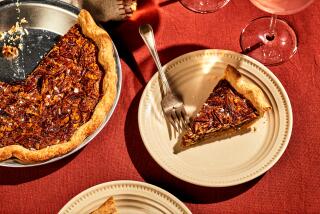Substituting Egg Yolks in a Fresh Lemon Pie Filling
- Share via
Question: Is there any substitute for the egg yolks in lemon pie filling? We like the homemade fresh lemon pie very much but cannot take the high cholesterol level of three or four egg yolks. Do you have a suggestion?
Answer: The egg yolks in lemon pie filling may be eliminated completely or replaced with more egg whites, if desired. Two whole eggs instead of four egg yolks may also be substituted. When eliminating the egg yolks, add another tablespoon of cornstarch (or unflavored gelatin) with a little water (to make up for the yolk liquid) in the filling to make up for the loss of thickening power.
Since egg yolks contribute not only flavor but color as well, you may want to add a drop or so of yellow food color to the filling. When using egg whites, which coagulate more quickly than egg yolks, cook the mixture for a shorter period than when using egg yolks. To make up for the fat and smoothness provided by the yolks, a teaspoon of butter may be added, if using butter does not pose a problem.
Q: Can you please print a method for making a tomato rose from tomato peel? I’ve always seen them done so artistically in some restaurants. I tried making a tomato rose once but it just didn’t look right so I gave up. There must be better way.
A: A continuous spiral of skin from around the tomato is the basis for a tomato rose. Use a sharp paring knife to cut out only the thin outer covering of the tomato--too thick a spiral will prevent a good shape and if too thin the skin will break.
Use a large, firm red tomato. Start at the base of the tomato, slitting the knife across the base into the skin to cut a caplike circle. Cut around in a spiral down to the other end of the tomato, making a 1/2- to 1-inch-wide strip, depending on size of tomato. The edges don’t have to be straight since a little jagged imperfection will create a natural look.
A simple way of creating the rose effect is to coil the peel tightly, starting at the caplike circle, making the center tighter. Secure with a wood pick, if necessary.
For a more realistic look, cut the long strip into two, making a longer strip out of the the one with the caplike circle. Using the longer strip, place cap base on flat surface and roll up the spiral to form the outer petals of the rose. Roll up the second spiral tightly and fit it into the center of the base. Garnish with green leaves. If preparing several hours in advance, prevent drying by carefully storing in a sealed plastic bag and refrigerating.
Q: At a restaurant recently we were served a green salad vinaigrette that included some interesting salad greens that we’d never seen or tasted before. The maitre d’ called them mache, a French word, I think. Now I would like to find out more about the green with your help.
A: Mache (also called lamb’s lettuce in English, as well as corn salad and field salad), is quite popular in Europe. A wild variety also grows in Italy and is called insalatina (little salad). Available in cooler weather, the mache has elongated spoon-shaped blue-green leaves that are rather firm and chewy. Since the taste of the mache is a little bland, it goes well with almost any salad ingredient and dressing. The vegetable is highly perishable, so it should be quickly refrigerated, wrapped, and used within one to two days.
Q: Lately I’ve noticed that large eggs, which I buy all the time, seem smaller than usual. Can you tell me what the weight of a large egg should be?
A: One large egg should weigh at least two ounces. Size is usually based on minimum net weight per dozen. Sizes are: Jumbo: 30 ounces, Extra Large: 27 ounces, Large: 24 ounces, Medium: 21 ounces, Small: 18 ounces and Pee Wee: 15 ounces.
Address questions on food preparation to You Asked About, Food Section, The Times, Times Mirror Square, Los Angeles 90053. Personal replies cannot be given.


